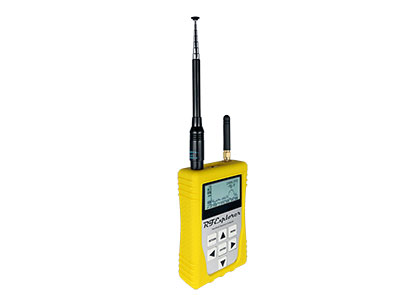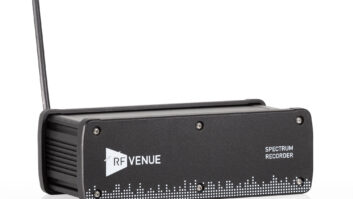
When it comes to wireless audio, there always seems to be a shroud of mystery around why a device works on some days in some venues but not on others. This is likely because the human eye cannot see the radio frequency link between the transmitting and receiving antennas. This is where the RF Explorer Handheld RF Spectrum Analyzer and RF Venue Vantage software (Mac only) come to the rescue.
The RF Explorer Handheld Spectrum Analyzer (see Fig. 1) offers a very affordable and portable alternative to some of the bulkier, high-dollar analyzers on the market. Together with the very reasonably priced Vantage software, this duo allows a simple, quick and precise picture of the active RF environment. Additionally, RF scans can be exported and then imported into third-party software for wireless device coordination.
The handheld unit tested here is made by RF Explorer while the Vantage software is manufactured by RF Venue, an unaffiliated, separate company and Website based out of Massachusetts. This latter company also makes a rackmount unit of the RF Explorer called RF Explorer RackPRO, not tested here.
Sniffing the Air
The RF Explorer reviewed here is the 3G combo, which offers two antenna connections for differently ranged frequency scan modules. Module 1 covers 240 to 906 MHz, a range encompassing the RF bands where most of the pro audio RF devices on the market reside. Module 2 covers a wider range, offering 15 to 2,700 MHz of analysis. This could be helpful when the need arises to scan WiFi activity (2.4 GHz), as there are some pro audio RF devices that do transmit in this range.
Setup and scanning are very simple. I began by attaching two of the three supplied, different-length antennas to the RF Explorer. I used the longest antenna for the 240- to 960MHz module and connected the shorter one to the 15- to 2,700MHz module. There wasn’t much indication as to which antenna was designed for which module, but any of the lengths could be used on either module. As long as the antenna you are using is at least a quarter-wavelength as long as the lowest frequency you want to analyze, you should be fine.
Next, I made sure the module I was going to use, in this case 240 to 960 MHz, was selected in the unit’s Frequency Menu. This must be done before connecting the RF Explorer to the computer, as you can’t change modules once the Vantage software is active. There are several other menu items that must be configured before the RF Explorer can be actively scanning with the software. The good news is that upon registering the software I was sent an email with a detailed set of video instructions. It took me about five minutes to get it all set.
Connection to the computer must be done in a specific order. With the handheld scanner turned off, I connected it via USB to my MacBook Pro that had the Vantage software installed. The RF Explorer immediately came to life and started scanning while being powered by computer’s USB port. Next, I opened the Vantage software, which took over displaying the normally black and white scans from the handheld unit in a high-contrast, easy to read, full-color display.
The RF Explorer is fine little scanner without being connected to the Vantage software, but I found its display small and hard to read. This is because the unit is designed to be portable so I can’t really fault it for that. It does offer great mobility for the operator when not connected to the computer, making it handy for walking the performance area or stage to find out if any RF interference sources are location-specific. Additionally, the internal battery in the RF Explorer is charged via USB, so it’s always ready to go.

The Vantage software offers easy export of .CSV files for use with third-party coordination software.
Vantage Software
The Vantage software offers three basic features. First, RF scanning: Simply use the menu at the top left of the display to choose some preset frequency ranges or choose a custom range. Custom frequency ranges can be made as finite at 1MHz wide or as broad as the chosen RF module on the scanner.
The second function is Monitoring. This lets the user select, monitor and label specific RF signals or devices. This is perfect for looking at or keeping an eye on the levels of your mission-critical signals. You can also set up a RF level threshold, which sends an alert if your monitored device falls below the mark. All monitored devices are also marked and labeled inside the active frequency scan window, allowing the user to see any points of possible interference.
The third function is Export. This allows for exporting of scan data. Exports can be a single scan, an average of multiple scans or a maximum of multiple scans. The user can decide from the drop-down menus how many scan passes are to be included within multiple scan exports. I chose to do an average of four passes between 240 and 960 MHz. After hitting the scan button and the four passes finished, I exported the scan as a .csv file. I was then able to easily import this into Shure’s Wireless Workbench 6 and use it to coordinate my wireless devices.
One of the things that I liked about using this scanner was the ability to scan a broad range of spectrum. I have been using Wireless Workbench for many years and sometimes was limited in how much bandwidth I was able to scan due to the range of the devices networked to the software. Having the ability to import a broadband scan saved me time and proved helpful. Although I relied on the handheld device and my Mac for running the Explorer and Vantage software, it should be mentioned that the RF Explorer can be used on a PC via the Touchstone software available from nutsaboutnets.com. Touchstone comes in a free version with limited ability, a fully functioning version for $49, or a separate Android mobile version for $49.
Summing It Up
I am adding the RF Explorer and Vantage software to my gig workbox. I love the simplicity of the layout and the portability. It’s a great tool that offers excellent visualization of the RF environment over a broad area of the spectrum. Its ability to run scans and monitor frequencies in real time in a live environment make it an excellent tool. Add to that the ability of Vantage to export scan data to be used with other wireless coordination software and it makes a very solid foundation on which to coordinate RF devices.
Kyle Welch is a live sound engineer and director of The Blackbird Academy’s Live Sound program in Nashville.
Try This
One of the things to watch out for in wireless frequency coordination is intermodulation distortion. Intermods are spurious wireless frequencies that are created when multiple wireless transmitters are in proximity to each other. A simple trick to try to avoid these IMDs is to make use of the manufacturer’s “Group” and “Channel” hierarchy. Assuming that all of your wireless devices are within the same frequency band by the same manufacturer, set all devices to the same Group, and then use different Channels within that group. These Channels are pre-calculated by the manufacturer to all work with each other and avoid transmitting on any created Intermods and will offer a set of frequencies that will work well together.
PRODUCT SUMMARY
COMPANY: RF Explorer
PRODUCT: RF Explorer Handheld Spectrum Analyzer 3G Combo
WEBSITE:j3.rf-explorer.com
PRICE: $269
PROS: Portable, compact, cost-effective, broadband spectrum analyzer.
CONS: Small, two-color display.
PRODUCT SUMMARY
COMPANY: RF Venue
PRODUCT: Vantage Software
WEBSITE:rfvenue.com
PRICE: $99
PROS: Easy to read, simple software design. Provides easy export of .CSV files for use with third-party coordination software.
CONS: Only available as a Mac OS app.







